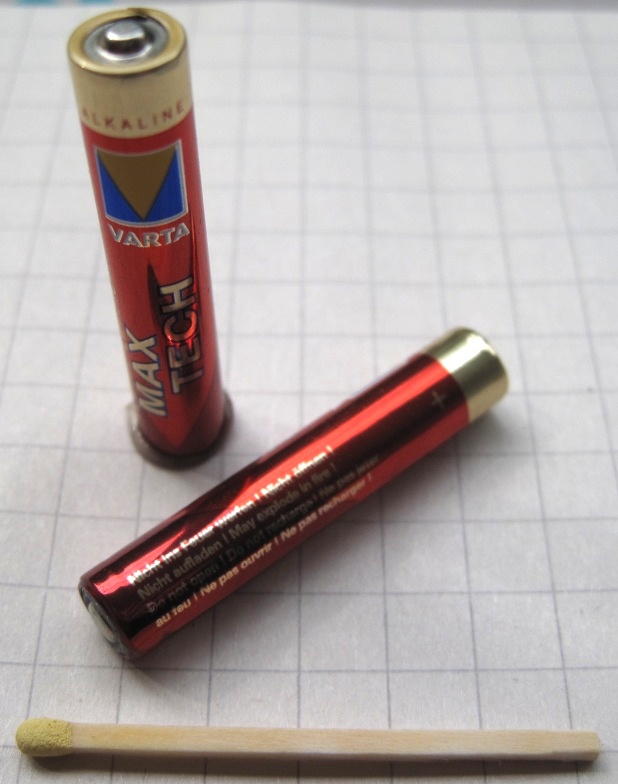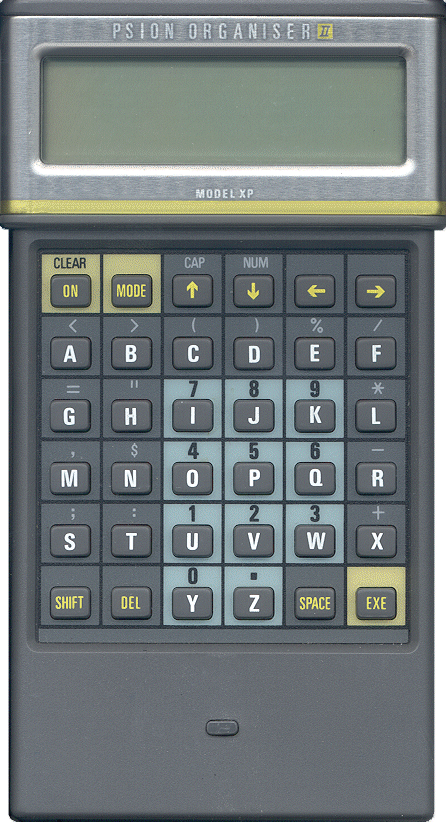|
Osaris
Osaris is a personal digital assistant (PDA) featuring the EPOC operating system (OS) distributed by Oregon Scientific. The Osaris was released in 1999, and at the time priced at to . The Osaris contains an 18.432 MHz CL-PS7111 (ARM 710) processor and is powered by two AA size batteries or an external power 6 volt AC adapter, with a 3 volt CR2032 cell providing backup power. The liquid-crystal display (LCD) is a touchscreen, backlit 320 × 200 pixels with 16 greyscale levels. There are also 10 membrane keys, 5 on each side of the LCD. The Osaris can be linked to a PC via an RS-232 link cable and IrDA (Infrared). The Osaris contains 8 MB of read-only memory (ROM), and, depending on the model, 4 MB, 8 MB or 16 MB random-access memory (RAM). The memory can also be expanded using CompactFlash. * Dimensions: 170 × 90 × 20 mm * Weight: c. 250 g After the debut of EPOC Release 5, the Osaris was the only PDA to use the EPOC Release 4 operating system. It also has the distinc ... [...More Info...] [...Related Items...] OR: [Wikipedia] [Google] [Baidu] |
EPOC (operating System)
EPOC is a mobile operating system developed by Psion, a British company founded in 1980. It began as a 16-bit operating system (OS) for Psion's own x86-compatible devices, and was later replaced by a 32-bit system for x86 and ARM. Psion licensed the 32-bit system to other hardware makers, such as Ericsson. To distinguish it from the 16-bit OS, the 32-bit version was sometimes called EPOC32. Technologically, it was a major departure from the 16-bit version (which came to be called EPOC16 or SIBO). In 1998, the 32-bit version was renamed Symbian OS. After Nokia acquired the rights to Symbian in 2010, they published Symbian's source code under the Eclipse Public License. In 2011, Nokia rescinded the open-source license for subsequent releases of the software. Name The name EPOC comes from the word ''epoch'' (the beginning of an era). The name was shortened to four letters to accord with the names of such software innovations as Unix and Mach. Initially the operating system was ... [...More Info...] [...Related Items...] OR: [Wikipedia] [Google] [Baidu] |
Symbian
Symbian is a discontinued mobile operating system (OS) and computing platform designed for smartphones. It was originally developed as a proprietary software OS for personal digital assistants in 1998 by the Symbian Ltd. consortium. Symbian OS is a descendant of Psion's EPOC, and was released exclusively on ARM processors, although an unreleased x86 port existed. Symbian was used by many major mobile phone brands, like Samsung, Motorola, Sony Ericsson, and above all by Nokia. It was also prevalent in Japan by brands including Fujitsu, Sharp and Mitsubishi. As a pioneer that established the smartphone industry, it was the most popular smartphone OS on a worldwide average until the end of 2010, at a time when smartphones were in limited use, when it was overtaken by iOS and Android. It was notably less popular in North America. The Symbian OS platform is formed of two components: one being the microkernel-based operating system with its associated libraries, and the othe ... [...More Info...] [...Related Items...] OR: [Wikipedia] [Google] [Baidu] |
Oregon Scientific
Oregon Scientific, Inc. is a manufacturer of electronics including digital clocks, home weather stations, public alert monitors, fitness devices, toys and globes. The firm was started in 1989 in Portland, Oregon, United States. In 1997, the company became a fully owned subsidiary of IDT (Integrated Display Technology), a Hong Kong–based company. Products OSI and its parent company introduced the world's slimmest MP3 player at the time, and the first digital, personal monitor for air quality. The company is known for its WeatherNow weather station built for home use that uses FM radio signals from MSN Direct to provide 4-days of regional weather information. Oregon Scientific made the first stand alone waterproof MP3 player. In 2007, CES Innovations award winners included the ATC2K Waterproof Action Cam, the Talking Wireless BBQ/Oven Thermometer and the WeatherNow II. Their Pendant MP3 Player and Waterproof MP3 player received awards for innovation at the 2005 Consumer Elec ... [...More Info...] [...Related Items...] OR: [Wikipedia] [Google] [Baidu] |
Serial Port
A serial port is a serial communication Interface (computing), interface through which information transfers in or out sequentially one bit at a time. This is in contrast to a parallel port, which communicates multiple bits simultaneously in Parallel communication, parallel. Throughout most of the history of personal computers, data has been transferred through serial ports to devices such as modems, computer terminal, terminals, various peripherals, and directly between computers. While interfaces such as Ethernet, FireWire, and USB also send data as a serial Stream (computing), stream, the term ''serial port'' usually denotes Computer hardware, hardware compliant with RS-232 or a related standard, such as RS-485 or RS-422. Modern consumer personal computers (PCs) have largely replaced serial ports with higher-speed standards, primarily USB. However, serial ports are still frequently used in applications demanding simple, low-speed interfaces, such as industrial automation sys ... [...More Info...] [...Related Items...] OR: [Wikipedia] [Google] [Baidu] |
List Of Battery Sizes
This is a list of the sizes, shapes, and general characteristics of some common primary and secondary battery types in household, automotive and light industrial use. The complete nomenclature for a battery specifies size, chemistry, terminal arrangement, and special characteristics. The same physically interchangeable cell size or battery size may have widely different characteristics; physical interchangeability is not the sole factor in substituting a battery. The full battery designation identifies not only the size, shape and terminal layout of the battery but also the chemistry (and therefore the voltage per cell) and the number of cells in the battery. For example, a CR123 battery is always LiMnO2 ('Lithium') chemistry, in addition to its unique size. The following tables give the common battery chemistry types for the current common sizes of batteries. See Battery chemistry for a list of other electrochemical systems. Cylindrical batteries Rectangular batteries ... [...More Info...] [...Related Items...] OR: [Wikipedia] [Google] [Baidu] |
Database
In computing, a database is an organized collection of data or a type of data store based on the use of a database management system (DBMS), the software that interacts with end users, applications, and the database itself to capture and analyze the data. The DBMS additionally encompasses the core facilities provided to administer the database. The sum total of the database, the DBMS and the associated applications can be referred to as a database system. Often the term "database" is also used loosely to refer to any of the DBMS, the database system or an application associated with the database. Before digital storage and retrieval of data have become widespread, index cards were used for data storage in a wide range of applications and environments: in the home to record and store recipes, shopping lists, contact information and other organizational data; in business to record presentation notes, project research and notes, and contact information; in schools as flash c ... [...More Info...] [...Related Items...] OR: [Wikipedia] [Google] [Baidu] |
Psion (company)
Psion PLC was a designer and manufacturer of mobile handheld computers for commercial and industrial uses. The company was headquartered in London, England, with major operations in Mississauga, Ontario, Canada, and other company offices in Europe, the United States, Asia, Latin America, and the Middle East. It was a public company listed on the London Stock Exchange () and was once a constituent of the FTSE 100 Index. Psion's operational business was formed in September 2000 from a merger of Psion and Canadian-based Teklogix Inc., and was a global provider of solutions for mobile computing and wireless data collection. The Group's products and services included rugged mobile hardware, secure software and wireless networks, professional services, and support programs. Psion worked with its clients in the area of burgeoning technologies, including imaging, voice recognition, and radio-frequency identification (RFID). They had operations worldwide in 14 countries, and customers ... [...More Info...] [...Related Items...] OR: [Wikipedia] [Google] [Baidu] |
CompactFlash
CompactFlash (CF) is a flash memory mass storage device used mainly in portable electronic devices. The format was specified and the devices were first manufactured by SanDisk in 1994. CompactFlash became one of the most successful of the early memory card formats, surpassing Miniature Card and SmartMedia. Subsequent formats, such as MMC/ SD, various Memory Stick formats, and xD-Picture Card offered stiff competition. Most of these cards are smaller than CompactFlash while offering comparable capacity and speed. Proprietary memory card formats for use in professional audio and video, such as P2 and SxS, are faster, but physically larger and more costly. CompactFlash's popularity is declining as CFexpress is taking over. As of 2022, both Canon and Nikon's newest high end cameras, e.g. the Canon EOS R5, Canon EOS R3, and Nikon Z 9 use CFexpress cards for the higher performance required to record 8K video. Traditional CompactFlash cards use the Parallel ATA interf ... [...More Info...] [...Related Items...] OR: [Wikipedia] [Google] [Baidu] |
Springer Science+Business Media
Springer Science+Business Media, commonly known as Springer, is a German multinational publishing company of books, e-books and peer-reviewed journals in science, humanities, technical and medical (STM) publishing. Originally founded in 1842 in Berlin, it expanded internationally in the 1960s, and through mergers in the 1990s and a sale to venture capitalists it fused with Wolters Kluwer and eventually became part of Springer Nature in 2015. Springer has major offices in Berlin, Heidelberg, Dordrecht, and New York City. History Julius Springer founded Springer-Verlag in Berlin in 1842 and his son Ferdinand Springer grew it from a small firm of 4 employees into Germany's then second-largest academic publisher with 65 staff in 1872.Chronology ". Springer Science+Business Media. In 1964, Springer expanded its business internationally, op ... [...More Info...] [...Related Items...] OR: [Wikipedia] [Google] [Baidu] |
Random-access Memory
Random-access memory (RAM; ) is a form of Computer memory, electronic computer memory that can be read and changed in any order, typically used to store working Data (computing), data and machine code. A random-access memory device allows data items to be read (computer), read or written in almost the same amount of time irrespective of the physical location of data inside the memory, in contrast with other direct-access data storage media (such as hard disks and Magnetic tape data storage, magnetic tape), where the time required to read and write data items varies significantly depending on their physical locations on the recording medium, due to mechanical limitations such as media rotation speeds and arm movement. In today's technology, random-access memory takes the form of integrated circuit (IC) chips with MOSFET, MOS (metal–oxide–semiconductor) Memory cell (computing), memory cells. RAM is normally associated with Volatile memory, volatile types of memory where s ... [...More Info...] [...Related Items...] OR: [Wikipedia] [Google] [Baidu] |
Read-only Memory
Read-only memory (ROM) is a type of non-volatile memory used in computers and other electronic devices. Data stored in ROM cannot be electronically modified after the manufacture of the memory device. Read-only memory is useful for storing software that is rarely changed during the life of the system, also known as firmware. Software applications, such as video games, for programmable devices can be distributed as ROM cartridge, plug-in cartridges containing ROM. Strictly speaking, ''read-only memory'' refers to hard-wired memory, such as diode matrix or a #Solid-state ROM, mask ROM integrated circuit (IC), that cannot be electronically changed after manufacture. Although discrete circuits can be altered in principle, through the addition of Jump wire, bodge wires and the removal or replacement of components, ICs cannot. Correction of errors, or updates to the software, require new devices to be manufactured and to replace the installed device. Floating-gate ROM semiconductor ... [...More Info...] [...Related Items...] OR: [Wikipedia] [Google] [Baidu] |










